ERF was one of the first manufacturers to specify the Perkins' Eagle Tx engine, which supersedes all other Perkins engines.
Page 26
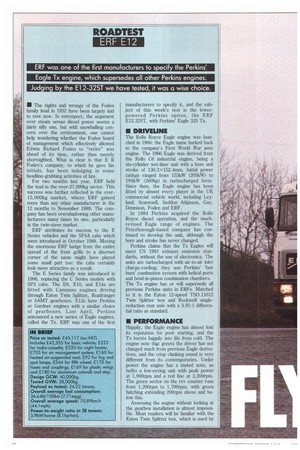
Page 28
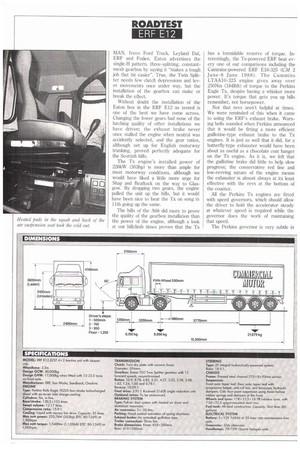
Page 29
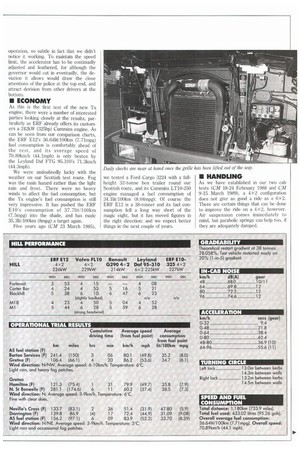
Page 30
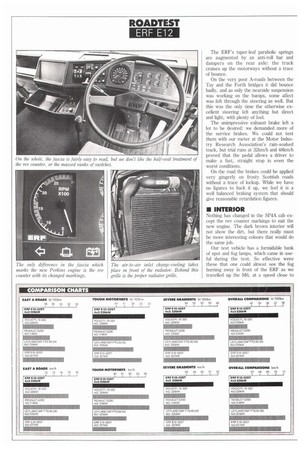
Page 31
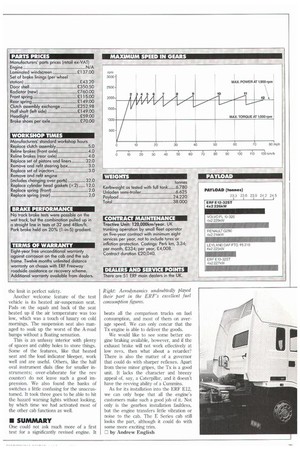
If you've noticed an error in this article please click here to report it so we can fix it.
Judging by the El 2-3251 we have tested, it was a wise choice.
• The rights and wrongs of the Foden family feud in 1932 have been largely laid to rest now. In retrospect, the argument over steam versus diesel power seems a fairly silly one, but with snowballing concern over the environment, one cannot help wondering whether the Foden board of management which effectively allowed Edwin Richard Foden to "retire" was ahead of its time, rather than merely shortsighted. What is clear is that E R Foden's company, to which he gave his initials, has been indulging in some headline-grabbing activities of late.
For two months last year, ERF held the lead in the over-27,999kg sector. This success was further reflected in the over15,000kg market, where ERF gained more than any other manufacturer in the 12 months to November 1989. The company has been overshadowing other manufacturers many times its size, particularly in the twin-steer market.
ERF attributes its success to the E Series vehicles and the SP4A cabs which were introduced in October 1988. Moving the enormous ERF badge from the entire spread of the front grille to a discreet corner of the same might have played some small part too: the cabs certainly look more attractive as a result.
The E Series family was introduced in 1986, replacing the C Series models with SP3 cabs. The E8, E10, and E14s are fitted with Cummins engines driving through Eaton Twin Splitter, Roadranger or SAMT gearboxes. E12s have Perkins or Gardner engines with a similar choice of gearboxes. Last April, Perkins announced a new series of Eagle engines, called the Tx. ERE was one of the first
IN BRIEF
Price as tested: £45,117 (ex-VAT).
Includes £42,355 for basic vehicle; £222 for radio-cassette; £520 for night heater, £705 for air management system; £160 for heated air-suspended seat; £92 for fog and spot lamps; £544 for fifth wheel, £170 for hoses and couplings; £169 for plastic wings and El 80 for aluminium catwalk and step. Design GCW: 40,000kg.
Tested GVW: 38,000kg.
Payload as tested: 24.22 tonnes.
Overall average fuel consumption: 36,6414/100km (7.71 mpg).
Overall average speed: 70.89km/h (44,1 mph).
Power-to-weight ratio at 38 tonnes: 5.9kW/tonne (8.1hp/ton), manufacturers to specify it, and the subject of this week's test is the lowerpowered Perkins option, the ERF E12.32ST, with Perkins' Eagle 325 Tx.
• DRIVEUNE
The Rolls Royce Eagle engine was launched in 1966: the Eagle name harked back to the company's First World War aero engine. The 1966 Eagle was derived from the Rolls C6 industrial engine, being a six-cylinder wet-liner unit with a bore and stroke of 130.2)(152.4mm. Initial power ratings ranged from 153kW (205kW) to 194kW (260hp) in turbocharged form. Since then, the Eagle engine has been fitted by almost every player in the UK commercial vehicle world, including Leyland, Scammell, Seddon Atkinson, Guy, Dennison, Foden and ERF.
In 1984 Perkins acquired the Rolls Royce diesel operation, and the muchrevised Eagle range of engines. The Peterborough-based company has continued to develop the unit, although the bore and stroke has never changed.
Perkins claims that the Tx Eagles will meet US 1991 exhaust emission standards, without the use of electronics. The units are turbocharged with air-to-air inlet charge-cooling; they use Perkins' fast burn' combustion system with helical ports and bowl-in-piston combination chambers. The Tx engine has or will supersede all previous Perkins units in ERFs. Matched to it is the Eaton 12-speed TSO.11612 Twin Splitter box and Rockwell singlereduction rear axle with a 3.91:1 differential ratio as standard.
• PERFORMANCE
Happily, the Eagle engine has almost lost its reputation for poor starting, and the Tx bursts happily into life from cold, The engine note that greets the driver has not changed much from previous Eagle derivatives, and the crisp clanking sound is very different from its contemporaries. Under power the engine has a muted note, as befits a low-reving unit with peak power at 1,9001pm and a red line at 2,200rpm. The green sector on the rev counter runs from 1,200rprn to 1,700rpm, with green hatching extending 200rpm above and below this.
Assessing the engine without looking at the gearbox installation is almost impossible. Most readers will be familiar with the Eaton Twin Splitter box, which is used by MAN, Iveco Ford Truck, Leyland Daf, ERF and Foden. Eaton advertises the single-H pattern, three-splitting, constantmesh gearbox by saying it "makes a tough job that bit easier". True, the Twin Splitter needs few clutch depressions and lever movements once under way, but the installation of the gearbox can make or break the effect.
Without doubt the installation of the Eaton box in the ERE,' E12 as tested is one of the best we have come across. Changing the lower gears had none of the lurching quality of other installations we have driven; the exhaust brake never once stalled the engine when neutral was accidently selected, and the gear ratios, although set up for English motorway trunking, proved perfectly adequate for the Scottish hills.
The Tx engine's installed power of 226kW (303hp) is more than ample for most motorway conditions, although we would have liked a little more urge for Shap and Beattock on the way to Glasgow. By dropping two gears, the engine pulled the unit up the hills, but it would have been nice to hear the Tx on song in 11th going up the same.
The hills of the A68 did more to prove the quality of the gearbox installation than the power of the engine, although a look at our hillclimb times proves that the Tx has a formidable reserve of torque. Interestingly, the Tx-powered ERF beat every one of our comparisons including the Cummins-powered ERF E10-325 (CM 2 June-8 June 1988). The Cummins LTAA10-325 engine gives away over 250Nm (184Ibft) of torque to the Perkins Eagle Tx, despite having a whisker more power. It's torque that gets you up hills remember, not horsepower.
Not that revs aren't helpful at times. We were reminded of this when it came to using the ERF's exhaust brake. Warning bells sounded when Perkins announced that it would be fitting a more efficient guillotine-type exhaust brake to the Tx engines. It is just as well that it did, for a butterfly-type exhauster would have been about as useful as a chocolate coat hanger on the Tx engine. As it is, we felt that the guillotine brake did little to help slow progress; the conservative red line and low-revving nature of the engine means the exhauster is almost always at its least effective with the revs at the bottom of the counter.
All the Perkins Tx engines are fitted with speed governors, which should allow the driver to hold the accelerator steady at whatever speed is required while the governor does the work of maintaining that speed.
The Perkins governor is very subtle in operation, so subtle in fact that we didn't notice it working. To maintain the speed Limit, the accelerator has to be continually adjusted and feathered, for although the governor would cut in eventually, the deviation it allows would draw the close attentions of the police at the top end, and attract derision from other drivers at the bottom.
• ECONOMY
As this is the first test of the new Tx engine, there were a number of interested parties looking closely at the results, particularly as ERF already offers its customers a 242kW (325hp) Cummins engine. As can be seen from our comparison charts, the ERF E12's 36.641it/100km (7.71mpg) fuel consumption is comfortably ahead of the rest, and its average speed of 70.89km/h (44.1mph) is only beaten by the Leyland DA FTG 95.310's 71.3krn/h (44.3mph).
We were undoubtedly lucky with the weather on our Scottish test route. Fog was the main hazard rather than the light rain and frost. There were no heavy winds to affect the fuel consumption, but the Tx engine's fuel consumption is still very impressive. It has pushed the ERF ElO's consumption of 37.71it/100km (7.5mpg) into the shade, and has made 35.31it/100km (8mpg) a target again.
Five years ago (CM 23 March 1985), we tested a Ford Cargo 3224 with a fullheight 32-tonne box trailer round our Scottish route, and its Cummins LT10-250 engine managed a fuel consumption of 34.1litilOOkm (8.04mpg). Of course the ERF E12 is a 38-tonner and its fuel consumption fell a long way short of the magic eight, but it has moved figures in the right direction: and we expect better things in the next couple of years.
• HANDLING
As we have established in our two cab tests (CM 18-24 February 1988 and CM 9-15 March 1989), a 4x2 configuration does not give as good a ride as a 6x2. There are certain things that can be done to improve the ride on a 4x2, however. Air suspension comes immediately to mind, but parabolic springs can help too, if they are adequately damped.
The ERF's taper-leaf parabolic springs are augmented by an anti-roll bar and dampers on the rear axle: the truck cruises up the motorways without a trace of bounce.
On the very poor A-roads between the Tay and the Forth bridges it did bounce badly, and as only the nearside suspension was working on the bumps, some affect was felt through the steering as well. But this was the only time the otherwise excellent steering felt anything but direct and light, with plenty of feel.
The unimpressive exhaust brake left a lot to be desired: we demanded more of the service brakes. We could not test them with our meter at the Motor Industry Research Association's rain-soaked track, but trial runs at 32km/h and 48km/h proved that the pedal allows a driver to make a fast, straight stop in even the worst conditions.
On the road the brakes could be applied very gingerly on frosty Scottish roads without a trace of lockup, While we have no figures to back it up, we feel it is a well balanced braking system that should give reasonable retardation figures.
• INTERIOR
Nothing has changed in the SP4A cab except the rev counter markings to suit the new engine. The dark brown interior will not show the dirt, but there really must be more interesting colours that would do the same job.
Our test vehicle has a formidable bank of spot and fog lamps, which came in useful during the test. So effective were these that one could almost see the fog burning away in front of the ERF as we travelled up the M6, at a speed close to the limit in perfect safety.
Another welcome feature of the test vehicle is its heated air-suspension seat. Pads on the squab and back of the seat heated up if the air temperature was too low, which was a touch of luxury on cold mornings. The suspension seat also managed to soak up the worst of the A-road bumps without a floating sensation.
This is an unfussy interior with plenty of spaces and cubby holes to store things. Some of the features, like that heated seat and the loud indicator bleeper, work well and are useful. Others, like the half oval instrument dials (fine for smaller instruments: over-elaborate for the rev counter) do not leave such a good impression. We also found the banks of switches a little confusing for the unaccustomed. It took three goes to be able to hit the hazard warning lights without looking, by which time we had activated most of the other cab functions as welt.
• SUMMARY
One could not ask much more of a first test for a significantly revised engine, It beats all the comparison trucks on fuel consumption, and most of them on average speed. We can only concur that the Tx engine is able to deliver the goods.
We would like to see some better engine braking available, however, and if the exhaust brake will not work effectively at low revs, then what about a retarder? There is also the matter of a governor that could do with sharper reflexes. Apart from thee minor. gripes, the Tx is a good unit. It lacks the character and breezy appeal of, say, a Caterpillar, and it doesn't have the revving ability of a Cummins.
As for its installation into the ERF E12, we can only hope that all the engine's customers make such a good job of it. Not only is the gearbox installation faultless, but the engine transfers little vibration or noise to the cab. The E Series cab still looks the part, although it could do with some more exciting trim.
E by Andrew English








































































































